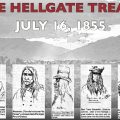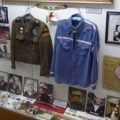
In 1869, the United States was still dealing with the aftermath of the Civil War. While the military turns its attention to pacifying Indian nations, the lawmakers look at ways to assimilate Indians by destroying Indian cultures, and former soldiers and others seek their fortunes by settling on Indian lands. Briefly described below are some of the American Indian events of 1869.
Military Actions
At Fort Cobb, Oklahoma, General Philip Sheridan remarks:
“The only good Indian I ever saw was a dead Indian.”
In Arizona, the Walapai under the leadership of Cherum and Leve Leve surrendered to the Army and were sent to the Colorado River Reservation. Several of their leaders were sent as prisoners to Alcatraz.
In Arizona, the U.S. Army began scouting for Yavapai camps to destroy in the Harquahala and Harcuvar Mountains. The Army strategy is to destroy the homes and resources of the Yavapai to force them to surrender.
In Arizona, the Yavapai under the leadership of Delshe and Skitlavisyah and the Tonto Apache under the leadership of Eschetlepan met with the army to negotiate peace. The Indians asked for a reservation on the east bank of the Verde River across from Fort McDowell. They expressed their willingness to relocate after harvesting the saguaro fruits and the summer crop of corn. While the military commander lacked the authority to establish the reservation he did assist the Yavapai in their peace efforts.
Land Ownership
In a discussion of appropriations for eleven treaties, one Representative discounted the recognition of Indian ownership of the land:
“They never owned a foot of land. They were roving savages. They never owned and could not own land.”
In New Mexico, in the case of United States versus Lucero, Chief Justice Watts characterized Indians as “wild, wandering savages”, but noted that this description did not hold for the Pueblos who, he claimed, had been cultivating the soil for three centuries. In his book Pueblo Nations: Eight Centuries of Pueblo Indian History, Joe Sando feels that the Judge was
“obviously ignorant of evidence that placed the Pueblo Indians in New Mexico thousands of years before the Spanish conquest, with walled villages, a sedentary life, and a principal occupation of agriculture.”
In Massachusetts, all restrictions on the sale of Mashpee land to outsiders were removed.
Indian Education
In Washington Territory, the Superintendent of Indian Affairs advocated taking children away from their parents, by compulsion or by compensation. He said:
“I am satisfied that many of the Indians would really part with their children for a small compensation in blankets and presents.”
In New Mexico, the Board of Foreign Missions of the Presbyterian Church sent a missionary to Fort Defiance to establish a school for the Navajo.
Disease
In Montana, smallpox hit the Gros Ventre and within weeks 741 of the tribe’s 2,000 people died. The River Crow, who often camped with the Gros Ventre, were familiar with the disease and moved out of the area as soon as they heard about the Gros Ventre plight. Most of the Crow moved to the Judith River basin which is about 100 miles away.
In Montana, smallpox struck the Blackfoot. In his book Mission Among the Blackfeet, Howard Harrod reports:
“However, this time the smallpox had a much more destructive effect upon the Blackfeet because it was combined with the liquor traffic in a marriage that finally placed intolerable strains upon traditional Blackfoot institutions.”
Tribal Leadership
In Oklahoma the Cherokees elected Lewis Downing as chief. Downing was opposed to the many corporate forces that were attempting to make a profit at the expense of the Indians. The Cherokee also passed a law which made it a criminal offense for any tribal citizen to advocate individual ownership of land or to sell land to anyone who was not a tribal citizen.
In North Carolina, the eastern Cherokee council elected George W. Bushyhead as chief.
In Wyoming, young Shoshone warriors openly grumbled about Chief Washakie wondering if the war blood had ceased flowing in his veins. Washakie disappeared for two months and then returned with seven scalps. Holding the scalps high, he asked:
“Let him who can do a greater feat than this claim the chieftainship. Let him who would take my place count as many scalps.”
In Montana, a number of Sioux bands (Hunkpapa, Sans Arc, Miniconjou, Oglala, Two Kettle, Yanktonai, and Blackfoot Sioux) gather along with some Northern Cheyenne and Arapaho along Rosebud Creek. The gathering was called by Sioux shirt wearer Four Horns who wanted to make Sitting Bull the head chief of the non-treaty bands. The four shirt wearers carried a buffalo robe to Sitting Bull’s lodge, placed him in the center of it, and then carried him to a special lodge. After making Sitting Bull head chief, Crazy Horse was made second chief. Historian Robert Larson, in his biography Gall: Lakota War Chief, writes:
“The importance of this Rosebud meeting would be difficult to overestimate. It meant that the Lakotas and their allies would strongly contest the presence of white intruders on the northern plains.”
In South Dakota, Brulé chief Spotted Tail shot and killed Big Mouth, a rival Brulé chief. Both men were drunk at the time.
Cheyenne oral historian Standing-All-Night died. According to Dave Hopkins, in his Montana State University Master of Education Thesis, A Brief History of Indian Education on the Tongue River Reservation:
“He was supposed to have been over one hundred years old, and he had handed down the stories of life and living from the elders before him.”
Grave Robbing
In South Dakota, a representative of the United States Army working for the United States Army Medical Museum robbed a Sicangu (Brulé) Lakota burial site. Both human remains and burial objects were stolen.
From 600 CE to 1250 CE, a large American Indian city-state called Mississippian was centered near present-day St. Louis. This culture was characterized by the construction of large earthen pyramids known as mounds. By 1869, Americans throughout the area were destroying the mounds, often looting grave goods from Mississippian graves. The great earthworks, pyramids, and burial mounds, which were found along the Ohio and Mississippi Rivers created problems for the Americans. It was important for the Euro-Americans of the nineteenth century to view Indians as savage, primitive, hunters and gatherers. While it seems obvious that Indians would have built these great works, this would have implied a level of Indian civilization which many Euro-Americans could not accept. The Americans promoted the idea that these structures must have been built by Vikings, or Celts, or some other “vanished” people. The Indians were, therefore, recent immigrants to the area.
In Missouri, a large Mississippian mound, known simply as The Big Mound, was destroyed as the city of St. Louis expanded. St. Louis at this time was known as Mound City for all of the mounds which dot its landscape.
In Illinois, the city of East St. Louis removed the European dead who had been interred on the top of the Mississippian mound known locally as Cemetery Mound. The mound was then destroyed. Two Indian tombs were discovered in the mound and were removed by a paleontologist from the Peabody Museum at Yale University.
Weiser Shoshone
In Idaho, a group of Americans visited the Weiser Shoshone camp of Chief Eagle Eye. Historian Hank Corless, in his book The Weiser Indians: Shoshoni Peacemakers, reports:
“They sat in silence for over two hours smoking a peace pipe, until the white men could no longer stand it and opened a dialogue.”
Eagle Eye told the Americans that his people were friendly and that they had no objection to having Americans live in their valley as long as they did not interfere with the Shoshone fishing rights. Eagle Eye also made it clear that they had no intention of being relocated to the Fort Hall Reservation. When the Americans returned to Boise, they reported that the Weiser Shoshone numbered about 70 and that they were well supplied with guns and horses.
Taxes
The Washington Territorial Legislature made distinctions between civilized or citizen Indians (non-tribal) and uncivilized (tribal Indians). The new revenue law exempted the property of Indians who were not citizens.
Annuities
In North Dakota, three Sioux bands – Cuthead Sioux, Wazikute Sioux, and Sisseton Sioux – arrived at Fort Buford and asked the commanding officers to provide them with rations. They were encouraged to stay near the fort so that the army could feed them and until the government could prepare a treaty.
Book
The Indians of Cape Flattery by James Swan provided a description of the Makah in Washington. In his biography James Swan, Cha-Tic of the Northwest Coast, George Miles writes of the book:
“The first detailed study of the Makah, it remains today a valuable account of their life before the great transformations that followed the federal government’s decisions at the end of the century to restrict sealing and whaling and to compel all Makah children to attend federal schools.”
Guns
Traders in Montana and Alberta began to supply the Blackfoot with breech-loading firearms and cartridges. The Blackfoot were regarded as one of the most powerful Indian nations on the Northern Plains.
Coal
The Cherokee, Choctaw, and Creek in Oklahoma passed laws regulating the leasing of coal claims.



Leave a Reply